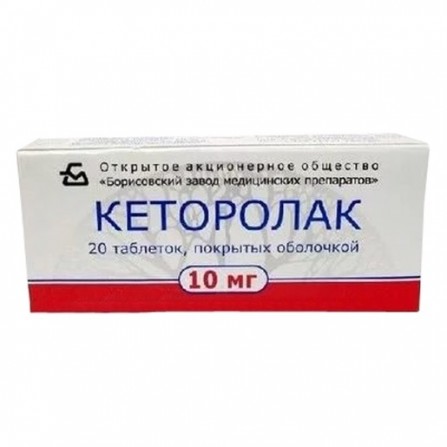Ketorolac-bsmp coated pills 10mg N20
Condition: New product
999 Items
Rating:
Be the first to write a review!

More info
Active ingredients
Ketorolac
Release form
Pills
Composition
Ketorolaka trometamol (Ketorolaka tromethamine) 10 mg Auxiliary substances: 118 mg lactose, 30 mg potato starch, 40 mg microcrystalline cellulose, 2 mg calcium stearate, 6 mg opadry.
Pharmacological effect
NPVS, pyrrolizin-carboxylic acid derivative. It has a pronounced analgesic effect, also has anti-inflammatory and moderate antipyretic effect. The mechanism of action is associated with inhibition of the activity of COX - the main enzyme in the metabolism of arachidonic acid, which is a precursor of prostaglandins, which play a major role in the pathogenesis of inflammation, pain and fever.
Pharmacokinetics
When ingestion is absorbed from the gastrointestinal tract. Cmax in plasma is reached in 40-50 minutes both after oral administration and after i / m administration. Food intake does not affect absorption. Plasma protein binding is more than 99%. T1 / 2 - 4-6 hours both after oral administration and after i / m administration. More than 90% of the dose is excreted in the urine, in unchanged form - 60%; the rest is through the intestines. In patients with impaired renal function and seniors, the elimination rate decreases, T1 / 2 increases.
Indications
For short-term relief of moderate and severe pain of various origins.
Contraindications
Erosive and ulcerative lesions of the gastrointestinal tract in the acute phase, the presence or suspicion of gastrointestinal bleeding and / or brain hemorrhage, a history of coagulation disorders, conditions with a high risk of bleeding or incomplete hemostasis, hemorrhagic diathesis, mild and marked renal impairment ( serum creatinine content of more than 50 mg / l), the risk of developing renal failure with hypovolemia and dehydration; "aspirin triad", bronchial asthma, nasal polyps, angioedema in history, preventive anesthesia before and during surgery, children and adolescents under 16 years of age, pregnancy, childbirth, lactation, hypersensitivity to ketorolac, acetylsalicylic acid and other NSAIDs .
Use during pregnancy and lactation
Contraindicated in pregnancy, during childbirth and during lactation (breastfeeding).Ketorolac is contraindicated for use as a means for sedation, supporting anesthesia and for anesthesia in obstetric practice, because under its influence may increase the duration of the first period of labor. In addition, ketorolac can inhibit uterine contractility and fetal blood circulation.
Dosage and administration
Adults with ingestion - 10 mg every 4-6 hours, if necessary - 20 mg 3-4 times / day. With intramuscular administration, a single dose is 10-30 mg, the interval between injections is 4-6 hours. The maximum duration of use is 2 days. Maximum doses: when taken orally or intramuscularly - 90 mg / day; for patients with body weight up to 50 kg, for violations of the kidneys, as well as for persons over 65 years old - 60 mg / day.
Side effects
Since the cardiovascular system: rarely - bradycardia, changes in blood pressure, heartbeat, fainting. On the part of the digestive system: possible nausea, abdominal pain, diarrhea; rarely - constipation, flatulence, a feeling of overflow of the gastrointestinal tract, vomiting, dry mouth, thirst, stomatitis, gastritis, erosive and ulcerative lesions of the gastrointestinal tract, liver function disorders. On the part of the central nervous system and peripheral nervous system: possible anxiety, headache, drowsiness; rarely - paresthesia, depression, euphoria, sleep disturbances, dizziness, changes in taste, visual disturbances, and movement disorders. On the part of the respiratory system: rarely - respiratory failure, asthma attacks. On the part of the urinary system: rarely - increased urination, oliguria, polyuria, proteinuria, hematuria, azotemia, acute renal failure. On the part of the blood coagulation system: rarely - nasal bleeding, anemia, eosinophilia, thrombocytopenia, bleeding from postoperative wounds. On the part of metabolism: possible increased sweating, edema; rarely - oliguria, increased creatinine and / or plasma urea, hypokalemia, hyponatremia. Allergic reactions: pruritus, hemorrhagic rash; in rare cases - exfoliative dermatitis, urticaria, Lyell's syndrome, Stevens-Johnson syndrome, anaphylactic shock, bronchospasm, angioedema, myalgia. Other: fever is possible. Local reactions: pain at the injection site.
Overdose
Symptoms: abdominal pain, nausea, vomiting, the occurrence of peptic ulcers of the stomach or erosive gastritis, renal dysfunction, metabolic acidosis. Treatment: gastric lavage, the introduction of adsorbents (activated carbon) and the conduct of symptomatic therapy (maintaining vital functions in the body).Not sufficiently eliminated by dialysis.
Interaction with other drugs
With the simultaneous use of Ketorolak with other NSAIDs, additive side effects may develop; with pentoxifylline, anticoagulants (including low-dose heparin) - may increase the risk of bleeding; with ACE inhibitors - may increase the risk of developing renal dysfunction; with probenecid - plasma ketorolac concentration and its half-life increase; with lithium preparations, a decrease in the renal clearance of lithium and an increase in its concentration in plasma is possible; with furosemide - reducing its diuretic action. With the use of Ketorolac, the need for the use of opioid analgesics for pain relief is reduced.
special instructions
It is used with caution in patients with impaired liver and kidney function, chronic heart failure, arterial hypertension, in patients with erosive and ulcerative lesions of the gastrointestinal tract and bleeding from the gastrointestinal tract in anamnesis. Ketorolac should be used with caution in the postoperative period in cases when especially careful hemostasis is required (including after resection of the prostate gland, tonsillectomy, in cosmetic surgery), as well as in elderly patients, since the half-life of ketorolac is lengthened, and plasma clearance may be reduced. In this category of patients, it is recommended to use Ketorolac in doses close to the lower limit of the therapeutic range. If symptoms of liver damage, skin rash, eosinophilia, ketorolac should be canceled. Ketorolac is not indicated for use in chronic pain syndrome. Impact on the ability to drive vehicles and control mechanisms If drowsiness, dizziness, insomnia or depression appear during the treatment with Ketorolac, particular caution should be exercised during classes of potentially hazardous activities requiring increased attention and quickness of psychomotor reactions.





